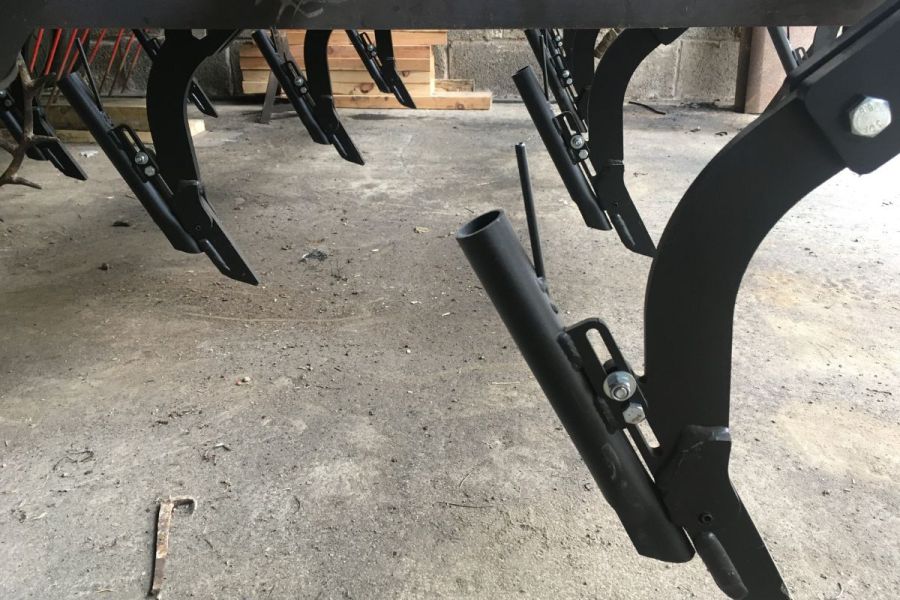Direct drilling into very heavy clays may be a step too far for many growers, but it hasn’t stopped a Derbyshire farmer who has made his own drill and has developed a new enthusiasm as he learns about regenerative agriculture. CPM finds out more.
“I couldn’t bring myself to spend that kind of money on a direct drill. So I ended up making one.”
By Lucy de la Pasture
North Derbyshire grower David Burton is doing the almost unthinkable; he’s moved to no-till across his 156ha farm. It’s a brave move considering his wildly variable soil comprises 63% clay at its heaviest but with soil health his priority, it’s a move that he believes will pay off.
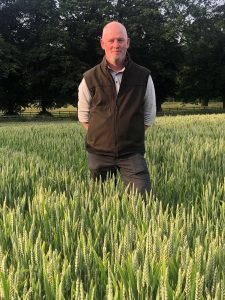
Changing his farming system to a more regenerative one has reinvigorated David Burton’s enthusiasm for farming as he continues to learn and head in directions he’d never previously thought of.
Some of the soils on his 156ha farm at New Tupton, just south of Chesterfield, were reinstated in the 1950s from opencast mining and, as a result, it’s not unusual to find a heavy strip through a field that’s entirely different from the land on either side. Deep tillage used to be David’s standard practice, but the plough has been redundant since 2014 when he made the decision to move to min-till.
“Since 2012, I’ve had an interest in direct drilling, but never really thought we’d get there as we farm some quite heavy opencast land. But in 2014 I took the decision to move to min-till, with a view to improving soil health and getting some organic matter in the soil, breathing better life into it.”
By 2020, David felt the soils were in a position to experiment a little further, so a friend and neighbour used his Moore Unidrill to put some barley in. “It was one of those fields with good land on both sides and a big heavy clay strip in the middle and I thought it’d be a good experiment to see whether the soil was in a good enough state to be able to cope with minimum soil disturbance,” recalls David.
“It did brilliantly, far better than any of the barley we put in that year, and I was just amazed. It really blew my mind and made me realise that there’s a different way to how we’d been doing things and perhaps we could make direct drilling work.”
Encouraged by the success, David began looking into buying a direct drill and did homework on all the brands on the market. “They all had pros and cons and I couldn’t quite decide which I liked. And then I came to the conclusion that it was basically just a cultivator with a drill hopper on the top. And once I’d made up my mind about that, I couldn’t bring myself to spend that kind of money on a direct drill. So I ended up making one.”

Steve Townsend sees his role as making practical sense of all the information that’s available about conservation agriculture and developing a strategy for the farm.
It was a chance conversation with Mike Metcalfe of JJ Metcalfe and Sons in January 2021 that made that possible. The following month, David started to build the drill using Metcalfe legs and coulters and 4-6 weeks and £4800 later his new drill was ready to get to work.
“We drilled some spring beans, spring oats and spring barley and everything but the spring barley did well. So the following autumn, we went the whole hog and put everything in with it,” says David.
It was another conversation with Mike that led conservation agriculture consultant Steve Townsend, of Soil First Farming, to become involved with the farm. “I rang Mike to ask a question and he said, ‘I’m giving you Steve Townsend number because as part of buying a set of legs, I’ll pay for half a day and Steve will put in half a day so you get a free day of advice’. So then Steve came to visit and that was that, he’s been advising me ever since and without realizing it, we’ve become regenerative.”
It was through Steve’s soil sampling that five soil types were identified on the farm, ranging from exceptionally high clay content to more easily manageable loams.
“David has the heaviest sort of soil to overcome, with one particular soil type at Clay Cross that’s 63% clay which takes some managing with reduced tillage. No-till is even trickier, especially when trying to earn a living and change the soil at the same time, which is a very difficult thing to do,” explains Steve.
“I have the dubious distinction of farming the heaviest land that Steve has on his books,” acknowledges David. “It’s challenging and that was one of the reasons we’d moved to a different way of doing things, because bringing the soil up and then trying to work it back down again was just very hard and very time consuming.
“It’s disheartening because it’s one of those soils where every four years we have a fantastic crop and then for the next three years, it’s absolute rubbish. It’s just sticky when wet and when it does dry, it dries out rapidly.”
And that’s where Steve comes in, to make practical sense of all the information that’s available about conservation agriculture and develop a strategy for the farm. “There’s an awful lot of unhelpful material out there and clients often say, they went the Groundswell and now they’re confused. It’s all about trying to sort out a strategy and a plan based on the principles of conservation agriculture, so minimising soil disturbance, keeping the soil covered with residue or green cover, and having diversity,” explains Steve.
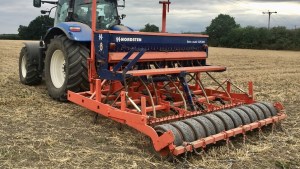
Coming in at a cost of around £4800, David Burton has made a bespoke direct drill using Metcalfe legs and tines.
For David’s farm, this has meant the introduction of mustard as a cover crop and the addition of winter beans to his rotation.
“I always naively thought the best way to raise soil organic matter was to chop straw and return the residues back. But the reality is there’s more to be gained from having living roots in the soil. One of the biggest pluses of mustard is its good strong taproot, with many roots per m2 and a big biomass. But only if you can get it in early enough,” adds David.
With this in mind, he’s taking Steve’s advice and will be purchasing an autocaster to put on the combine for this harvest. “We found that if you established mustard after winter barley, it got chest high. If you established after wheat, it got thigh high and if you established it in September it got to the top of your wellingtons, and any later than that, it was no higher than your foot. So we’ve realised timing is the key.
“So we’re hoping to cast a cover crop, mainly mustard, into the stubble as the combine cuts it and then as soon as either the straw is chopped or we’ve baled it, we’re going to go in and roll it very hard. Firstly, to push the cover crop in so it will hopefully germinate and, secondly, to just disturb it enough to wake up any grassweeds and get them to germinate.”
When it comes to flailing the cover crop back down before drilling into it, timing is also of the essence, he highlights. “One thing Steve told me, which I didn’t realise, is that when a brassica plant flowers, the root goes from being soft to woody, as it has more lignin. So if you wait until it’s flowered before you destroy it, the root will survive in the soil longer – up to three years, providing drainage and aeration of the soil.”
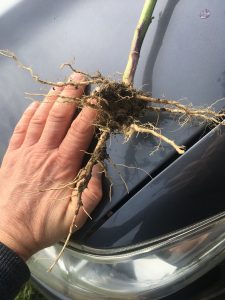
Maintaining living roots in the soil is an important part of the farm’s strategy, with mustard the cover crop of choice because it’s relatively cheap, has a big rooting system and above ground biomass.
David’s rotation was winter beans, winter wheat, spring naked oats, winter wheat, spring barley and back into winter beans, though oilseed rape has crept back into the rotation of late. “It seems to be a rotation that works quite well and it gives us two spring crops to deal with grassweeds.”
Although blackgrass and brome are present, Steve says David’s grassweed levels have dropped like a stone since he made the move to no-till. “He’s still got them, but they are very much lower than they used to be. So that’s a plus because it shows that the strategy is bearing fruit.”
There’s always a conversation that leads to nutrition when considering soils, says Steve, and that can be particularly important in the ‘adoption phase’ of no-till. “We build around soil management so that inputs can be reduced, when appropriate. The big one being nitrogen.”
Steve’s not a fan of the growing perception that a good crop of wheat can be grown with next to no nitrogen. “We take a planned approach because while you can grow a crop with very low N for one or possibly two years, over time the yield will slip quite dramatically. This is something the experience of the French has taught us. You can’t have something for nothing, you can cut down on what you buy but you still need to make sure the plant can get N.”
Nitrogen reduction is something that David is achieving. “We’d normally apply 200-220kgN/ha. Last year we aimed for 150kgN/ha, under Steve’s advice, but when we reached 120kgN/ha, the plants were healthy enough and it was so dry that we took the view that it was enough.”
The system has been tweaked again in 2023, with foliar urea applications for the first time to top up the 127kgN/ha of granular applied this spring. David participated in Joel Williams’ online webinar series this spring and is melting urea for the first time, splitting 20kgN/ha over four applications. “I’m still learning so I’ve decided to apply caution and put on a weaker dose to start.”
Although he says Steve doesn’t believe it’s necessary based on the results of the company’s own trials work, David feels more comfortable adding a long chain carbon source to the foliar urea, as advocated by Joel. “I looked at prices of fish hydrolysate, humic acid and molasses and found they were expensive, so I’ve used livestock molasses from a local supplier and I haven’t had any problems with nozzles or filters.”
But nitrogen is just one nutritional element, albeit an important one. Phosphate availability can be an issue when the soil biology comes to life, highlights Steve. “You’ve either got a soil that’s got plenty of phosphates in it or you haven’t, but when you start reducing your tillage you can find that you get biologically-induced phosphate deficiency even if there is phosphate in the soil.
“The bugs take over and they’ll take all the available phosphate and then, if there’s any leftover, the crop can have it. It’s a simplistic explanation of what happens, but none the less accurate,” he adds.
“The phosphate could be Index 3 and the plant can suffer, so it’s working through these nutritional mazes when you stop moving the soil, which can be very beneficial but also can be problematic – particularly in the adoption phase, which is usually the first five years.”
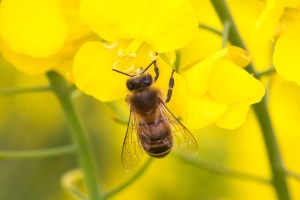
Steve encourages farmers to use their eyes. For example, OSR should have deep yellow flowers and pale petals are an indicator of sulphur deficiency.
Although tissue or SAP testing can be useful tools, Steve says he can generally predict what the crop will need from comprehensive soil testing. Tissue testing can be very variable and gives information that’s historic by the time the results arrive. But he also encourages farmers to use their own eyes. “I encourage farmers to bring their own instinct, particularly going down this different way of farming. The plant will tell you an awful lot if you know what to look for.
“You can see whether it looks green and healthy, the right colour green by the way, that it’s got no stripes or spots on the leaves, no indications that a particular element may be short.”
He uses OSR as an example. “You want a deep yellow flower when it’s in full bloom, it should be very, very yellow. And driving around the country, you can see crops that aren’t yellow. They’ve got a lot of light, whiter coloured pigmentation coming into their petals, which tells you that that it’s sulphur deficient.”
Brix is a better job as it gives a good overall of picture of plant health, believes Steve, and David has been busy monitoring crops with his refractometer this spring, which isn’t something he’d previously considered doing.
“The direct drilling and regenerative farming is a wormhole you end up going down. It becomes addictive and sends you in directions that you didn’t think you’d be going in,” says David. “It’s ignited my enthusiasm. Instead of just waiting for a crop to grow, I’m looking at it and wondering why it’s doing this and what’s the reason for that.”
David’s at the start of his direct drilling journey and says it’s a work in progress on his challenging heavy clay land. “When we started min till, we definitely got more of a seedbed and found water was starting to drain away where it used to just sit like a wet soup on the top in winter. Since we have direct drilled Clay Cross, we’ve never done fantastically well. But we’re putting roots into it and now we’re really starting to get a friable surface to it. But obviously it’s a commitment at the expense of yield at the moment, but I think in time that will come.”
This article was taken from the latest issue of CPM. For more articles like this, subscribe here.
Sign up for Crop Production Magazine’s FREE e-newsletter here.

